Vehicle Systems Overview
Modern automobiles are intricate technical systems composed of several vehicle systems each with specific design functions. Many of these systems include thousands of parts, which have evolved through advancements or the introduction of new technologies. Additionally, some vehicle systems have been developed in response to factors like air pollution, safety regulations, or competition among manufacturers.

A vehicle has many mechanical components and devices forming its various systems. Each serves a specific purpose. some examples of these vehicle systems include fuel system, transmission system, suspension system, braking system, steering system, cooling system, electrical system, and exhaust system. Engineers need to consider the reasons for positioning each system within the limited vehicle space.
What is a vehicle system?
Vehicle systems are a collection of interconnected parts that serve a particular function. For example, the Body and Chassis System includes the body, frame, suspension, steering, and braking components. The goal of this system is to support, stop, and enclose the car’s parts.
Internal Combustion Engine
Part of the drivetrain, the engine’s role is to convert fuel into motion. But how does it operate? Internal combustion engines generate energy by igniting a fuel-air mixture under pressure within the cylinder. This energy is then converted into movement through the engine’s pistons, connecting rods, and crankshaft.

Internal combustion engines offer exceptional drivability and durability. There are over 250 million highway vehicles in the United States, and they depend on them. In addition to gasoline/ diesel, engines can run on renewable/alternative fuels such as natural gas, biodiesel, or ethanol. They can also be paired with hybrid electric powertrains to improve fuel efficiency or plug-in hybrid electric systems to extend the vehicle’s range.
Automotive Exhaust System
Internal combustion engines cannot convert all the energy from fuel into mechanical energy. About 40% of the energy is lost to the atmosphere as high-temperature exhaust, with exhaust temperatures reaching around 500°C. Your vehicle’s exhaust system aims to perform four essential functions: collecting gases from the engine, removing harmful toxins from those gases, reducing engine noise, and discharging the gases away from the car’s occupants.
What does a full exhaust system include?
Your vehicle’s exhaust system comprises a complex network of pipes and devices. The main components of the exhaust system include the exhaust manifold(s), oxygen sensors, catalytic converter(s), resonator, exhaust pipes, muffler, and tailpipe. The exhaust manifold is directly connected to the engine and directs combustion gases into the exhaust system.

What is the automobile emission?
Vehicle emissions are often seen as a minor source of environmental pollution; however, the large number of vehicles on the roads makes them a significant contributor to atmospheric contamination. The transportation sector is responsible for approximately 35% of carbon monoxide, 30% of hydrocarbons, and 25% of nitrogen oxides in the atmosphere. These pollutants pose various threats to both the environment and human health, making the exhaust system a crucial component of internal combustion vehicles.

Does the exhaust system quiet the noise of combustion?
Although the primary function of the exhaust system is to expel harmful gases generated by the engine’s combustion chamber, it is also responsible for reducing noise. Exhaust-system tailpipe noise is a major factor in the overall sound quality of an automobile. Modern drivers require their vehicles to be both functional for daily travel and comfortable. As a result, minimizing noise, vibration, and harshness (NVH) has become crucial.

Sound quality, a significant aspect of automotive NVH performance, influences both consumer purchasing decisions and automakers’ competitiveness. Evaluating customer expectations regarding automotive noise sound quality has become an increasingly important research focus. Additionally, the noise radiated by the automobile exhaust system significantly impacts people’s physical and mental health. Noise from the exhaust system is a form of noise pollution, and prolonged exposure can lead to hearing loss, sleep disturbances, chronic stress, reduced productivity, and even heart failure. The transportation sector is a major source of noise, with vehicles emitting sound from both the engine and the exhaust pipe. Engineers can improve the acoustical properties of the exhaust system by enlarging the muffler to reduce exhaust noise.
Vehicle Fuel System
A smoothly running vehicle relies on a well-designed fuel system that ensures efficient fuel delivery to the engine. A vehicle’s fuel system includes components that transport fuel from the gas tank to the engine. This system consists of a fuel pump, fuel lines, a fuel pressure regulator, a fuel filter, and fuel injectors.

Why are fuel tanks positioned where they are in a vehicle?
Fuel tanks are strategically positioned above or in front of the rear axle in vehicles to maximize safety in the event of a collision. This placement provides greater protection for the fuel tank, reducing its exposure to damage. Studies have shown that positioning the fuel tank in this protected area can significantly reduce the risk of fires in rear-end collisions—by as much as 77%.
Additionally, modern vehicles are equipped with safety features like an inertia fuel switch (IFS). This system automatically cuts off the fuel flow during a collision or rollover. In newer models, the IFS is integrated with the vehicle’s computer system, which also manages other safety mechanisms like airbag deployment and electronic throttle control, further enhancing crash safety by stopping the fuel supply while allowing the driver to maintain control of the vehicle’s steering.
Vehicle Steering System
The steering system is a crucial element of a vehicle, responsible for guiding the car’s direction while on the road. To alter the car’s path, the driver must apply sufficient steering torque to overcome resistance from the road surface. This can lead to driver fatigue and decreased comfort. To address this issue, modern cars are frequently equipped with power-assisted steering systems.
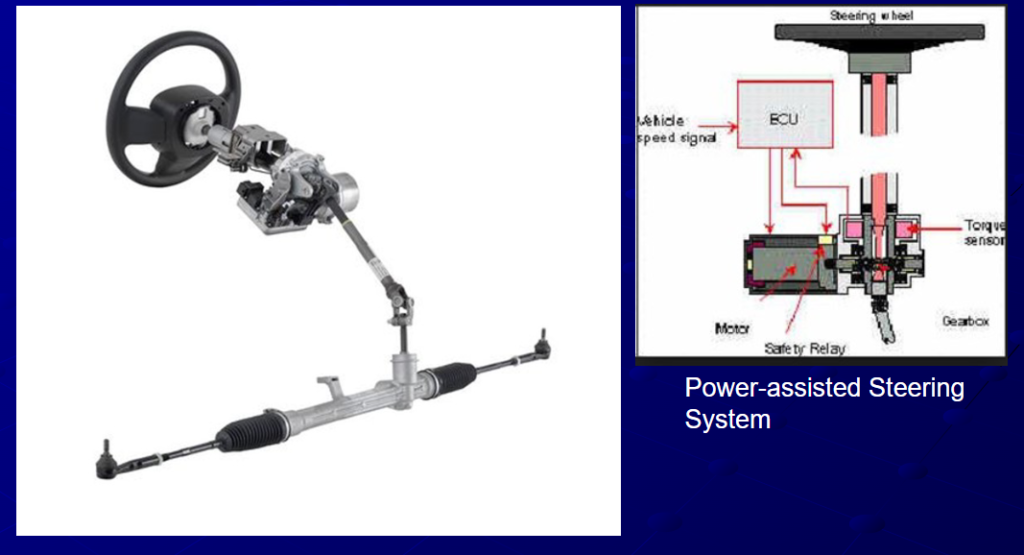
typical components found in a steering system include a steering column linked to a horizontal rod, known as the rack, which moves from side to side. The rack engages with a pinion gear, and as the steering wheel is turned, the rack shifts, causing the car’s wheels to turn correspondingly. This system is direct and responsive, providing precise control.
Why is steering needed in a car?
In simple terms, it functions as an assisting hand for drivers. This mechanical system reduces the effort needed to turn the wheels of a moving vehicle. It achieves this by utilizing various components, such as a power steering pump, a hydraulic system, an electric motor, and a steering gear or rack.

The steering system serves as the communication link between the driver, vehicle, and road. During driving, the driver directs the vehicle’s movement through steering actions. Therefore, the steering system must respond to the driver’s inputs swiftly and effectively, while also ensuring excellent handling stability. This is a critical aspect of the design of the steering controller. The typical structure of an electric power steering system generally consists of a steering wheel, torque sensors, an assist motor with a gearbox, and a rack and pinion, among other components.
What is the steer-by-wire system for cars?
Advanced X-by-wire technologies are crucial for the advancement of intelligent vehicles. One such technology is steer-by-wire, which eliminates the mechanical connection between the steering column and the steering actuator. Instead, the driver’s steering inputs are transmitted to the steering actuator via electrical signals. This type of steering supports autonomous driving by saving space, enabling flexible chassis design, and enhancing vehicle maneuverability and stability.
A steer-by-wire system seeks to remove the physical link between the steering wheel and the car’s wheels. It uses electrically controlled motors to adjust the direction of the wheels and deliver feedback to the driver.
Vehicle Suspension System
The suspension system consists of a set of mechanical components that connect the wheels to the frame or chassis of the vehicle. Engineers have extensively focused on suspension systems to enhance vehicle ride quality, handling, passenger comfort, and safety. Addressing noise, vibration, and harshness (NVH) is crucial from the customer’s perspective, as vehicle comfort and stability are prioritized. In passenger cars, shock absorption and vibration caused by random disturbances are common, and the suspension system plays a key role in mitigating these shocks.

Recently, suspension systems have become crucial in vehicle design. According to the standard ISO 2631, constant exposure to vibrations, particularly in the frequency range of 0.5 to 20 Hz, can cause various health issues in the human body. Consequently, automotive suspension system design aims not only to maintain effective wheel-road contact (road holding) but also to enhance passenger comfort by isolating the vehicle body from road irregularities.
Vehicle Braking System
The braking system is engineered to transform the vehicle’s kinetic energy into thermal energy. It comprises various components such as brake pads, brake rotors, calipers, and brake fluid. When the driver engages the brakes, the brake pads press against the brake rotors, creating friction that reduces the speed of the vehicle’s wheels.

Automotive Climate Control (HVAC) System
Climate control continuously monitors the temperature inside the car and automatically adjusts to heat or cool the cabin as needed. In contrast, air conditioning is a more manual system where you set the temperature and fan speed, and it maintains those settings until you change them yourself.

Automotive Aeroacoustics
The noise from a car’s HVAC system air outlet has recently attracted significant research interest. Aeroacoustic noise is increasingly important in automotive HVAC systems, especially in quieter electric vehicles, as less noise means greater acoustic comfort. In addition to wind noise and other sources, reducing ventilation system noise is crucial for premium comfort. HVAC unit noise can be categorized into low-frequency and high-frequency noise. Low-frequency humming and buzzing are usually caused by components like the blower and condenser.
The noise produced by a car’s HVAC system air outlet has recently garnered significant research interest. Aeroacoustic noise is becoming increasingly important in automotive HVAC systems, especially in electric vehicles, which are relatively quiet. Less noise translates to greater acoustic comfort. Besides wind noise and other noise sources, reducing the noise from the ventilation system is essential for premium comfort. The noise generated in an HVAC unit can be classified into low-frequency and high-frequency noise. Low-frequency humming and buzzing are typically due to components such as the blower and condenser.
Does running the AC reduces a vehicle’s fuel economy?
Yes, using your car’s air conditioning (AC) can lower fuel efficiency, particularly in hot weather and during short trips. Of all the vehicle systems this is the largest auxiliary load on a vehicle, contributing to 3.9% of the total greenhouse gas emissions of cars and light trucks. According to the EPA and Department of Energy, AC usage can decrease fuel economy by up to 25%. The energy consumption of climate control systems has garnered increased attention from research communities, industry, and regulatory agencies, primarily because of its significant impact on the range of electric vehicles.
Safety Systems
Safety systems in vehicles are crucial for protecting occupants and preventing accidents. These systems can be broken up into two categories, active and passive systems. Active vehicle safety features utilize cameras and sensors to assist drivers, while passive safety systems stay on standby, ready to perform a specific safety function if an accident occurs.
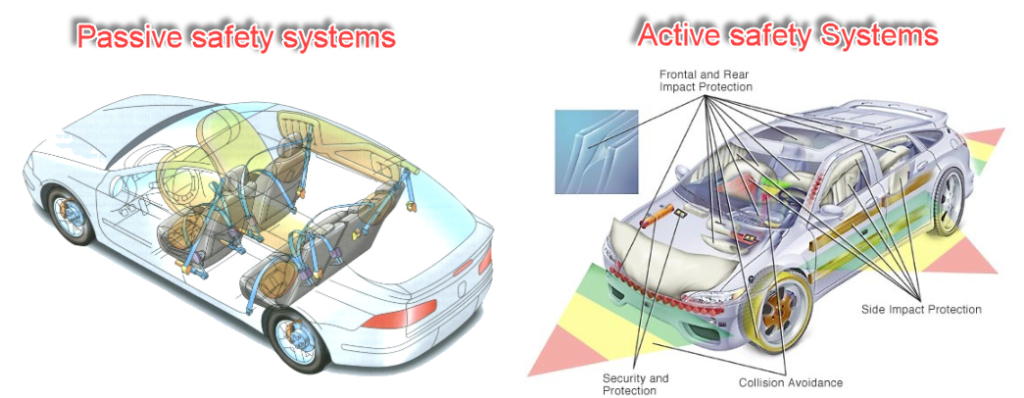
An example of an active safety system is the collision avoidance system. This vehicle system uses sensors and controls to detect potential collisions and alert the driver or even take corrective actions to avoid or mitigate the impact. These systems work together to enhance the safety of vehicles and reduce the risk of injury or damage in the event of an accident.
When did automakers start using seatbelts?
In 1968, the National Highway Traffic Safety Administration (NHTSA) mandated seatbelts in passenger vehicles (Federal Register 1966). Federal Motor Vehicle Safety Standard (FMVSS) 208 required that passenger vehicles be equipped with seatbelts at every forward-facing designated seating position.
Why is my seatbelt beeping?
A seatbelt warning light typically illuminates when you or a passenger in your car isn’t wearing a seatbelt. Seat belts are one of the most basic yet effective safety features, securing passengers in place during a collision. The Federal Motor Vehicle Safety Standard (FMVSS) 208 mandates that all passenger vehicles must emit an audible signal for 4 to 8 seconds and display a visual warning for 60 seconds if the driver is unbuckled at ignition.
Is it safe to ride in a car with the seat reclined?
Riding in a car with the seat reclined is not safe. As the seat reclines, the risk of injury or death for both drivers and passengers increases. Reclined postures pose significant challenges for crash safety because the occupant kinematics differs from when seated upright. With the rise of self-driving vehicles, more passengers may choose to recline and rest. However, this increases the difficulty of protecting them in the event of an accident. Therefore, it’s best to avoid reclining the seat while the car is in motion to minimize these risks.

When were airbags added to cars?
Airbags were first introduced in vehicles in the early 1970s, following more than a decade of research and development on inflatable restraints. By the late 1980s and early 1990s, airbags had become available in vehicles, with enough field data to assess their effectiveness in frontal crashes. By the early 1990s, front airbags had become standard equipment in passenger vehicles. Since model year 1998, all new cars have been required to have airbags on both the driver and passenger sides. Light trucks followed suit in 1999.
What do airbags do?
Airbags provide crucial protection in the event of a crash by inflating rapidly upon impact to cushion occupants from the force of the collision. They are designed to prevent your head, neck, and chest from hitting the dashboard, steering wheel, or windshield during a crash. As one of the most effective safety features in automobiles, airbags have evolved to protect occupants in frontal and side crashes. They help produce vulnerable areas such as the knees and chest. In modern vehicles, they are integral to standard safety packages, significantly reducing the risk of serious injury.

The risk of serious head injury in frontal crash tests at 40–48 km/h (25–30 mph) was 5.495% for drivers and 4.435% for passengers without seatbelts or airbags. This risk was significantly reduced by 80.5% to 1.073% for drivers and by 82.0% to 0.797% for passengers in 35 mph NCAP crash tests when both seatbelts and airbags were used.
Vehicle Electrical Systems
The electrical system encompasses major components such as the battery, alternator, wiring harnesses, and starter, along with the circuitry, control modules, fuses, switches, and other elements necessary for your vehicle’s operation.
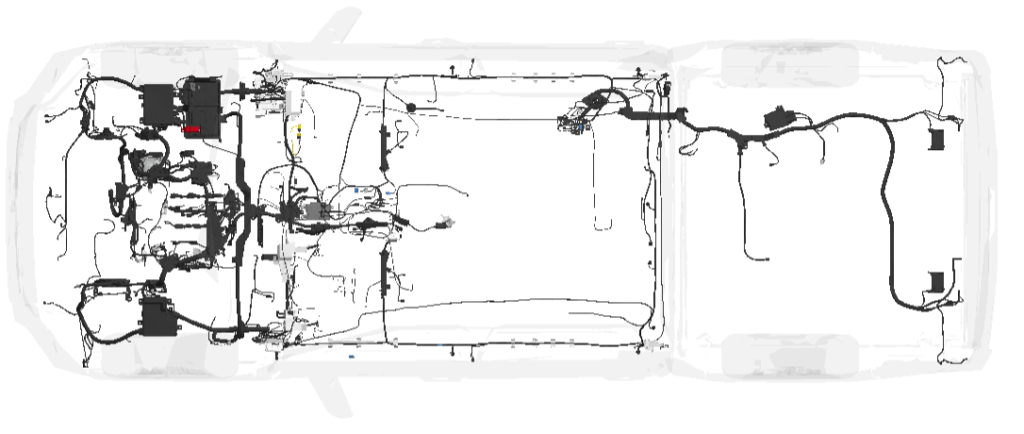
Charging System
Charging systems provide electrical energy to power your vehicle while it’s running and maintain the battery’s charge. This system includes three components: the battery, the alternator, and the voltage regulator.

The core of a car’s electrical system is its 12V lead-acid battery. The battery delivers the essential electrical power needed to start the engine. It also powers all vehicle components, from lights to windshield wipers while the vehicle is off. The alternator maintains this power flow by generating an electrical current via a belt drive mechanism when the engine is running.
Ignition System
The ignition system’s role is to ignite the air-fuel mixture in a gasoline engine. Alongside the spark plugs that ignite within the combustion chambers, the system includes an ignition coil, which converts battery voltage to a higher voltage, and the spark plug wires that connect these components.

Audio / Sound System -Components
Vehicle audio systems are installed in cars or other vehicles to provide entertainment and information for the occupants. Most factory audio systems include a head unit and four speakers, along with an amplifier. Due to space and cost considerations, these systems typically feature a low-power amplifier integrated into the head unit.

Body Exterior and Vehicle Interior
The body exterior and vehicle interior comprise several systems. The exterior includes body-in-white, which provides structural support and protection, and panels that contribute to the vehicle’s aesthetics and aerodynamics.
Functions of the Vehicle Body
The vehicle body-in-white serves several crucial functions. The body is designed to absorb crash energy, providing a safe environment for occupants. It also plays a role in reducing aerodynamic drag, which enhances fuel efficiency and performance.
Types of Vehicle Bodies
There are three basic construction configurations for vehicles: body on frame, unibody (also known as unitized body), and space frame. The body-on-frame construction offers several benefits. With suspensions and the powertrain mounted directly on the frame, there is ample space for suspension components, wheels, tires, and powertrain systems. Additionally, this design provides plenty of room for passengers and cargo, making it versatile and practical for various vehicle types.

In a unitized body, also known as unibody construction, sheet metal body parts are combined with load-bearing elements to form the body and frame as a single construction. This integration results in a more cohesive and lightweight vehicle structure.
What is a car door called?
A car door is a type of automotive door that usually hinges on its front edge. However, some doors can also operate through other mechanisms like tracks, as seen on minivans. Doors commonly feature side windows to provide visibility from inside the car and can be locked to secure the vehicle. A vehicle typically has two types of doors: front doors and rear doors. These can also be referred to as slide closures.

What does slamming a car door do?
Slamming a car door can create abnormal vibration and noise, which directly impacts the NVH of the vehicle. This can negatively affect a customer’s first impression of the vehicle. Over time, repeatedly slamming the door can lead to structural and functional issues, including potential damage to the door itself. In some cases, this damage can cause the door to collapse or become stuck, especially if moisture accumulates inside, leading to excessive corrosion.
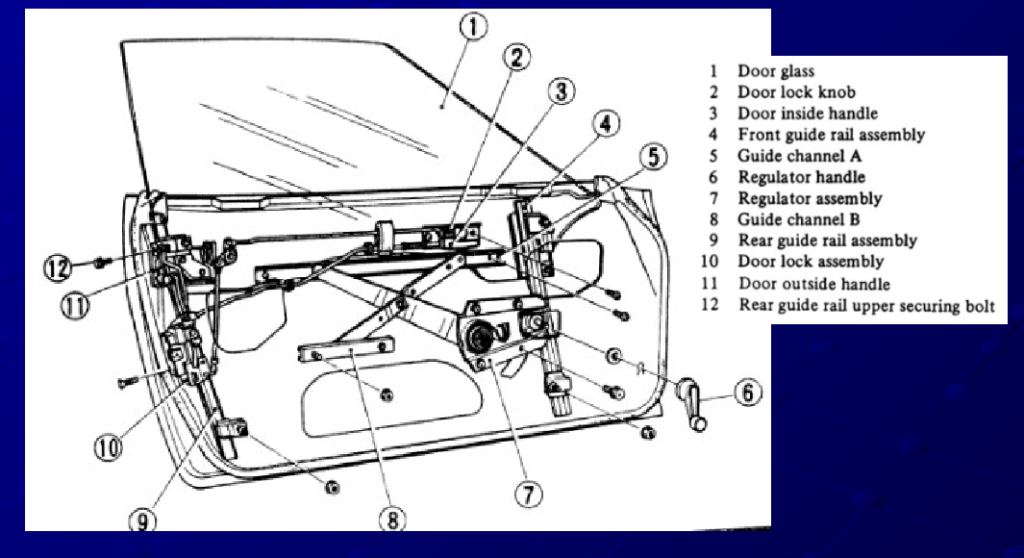
What does a car door seal do?
A car door seal, also known as automotive weather stripping, serves to isolate the passenger compartment from water, dust, and wind noise. Door seals are installed in the narrow gaps between the door and body frame along the perimeter of the opening panels. Additionally, the door seal has a significant impact on the door-closing performance. Which is influenced by its Compression Load Deflection (CLD) property. Traditional seals with uniform cross-sections can struggle with proper fitting in areas with large curvatures, potentially affecting the effort required to close the door accurately.

What are car interior parts?
Car interior parts include various components that enhance both the functionality and aesthetics of the vehicle. These parts consist of the dashboard panel, which provides essential information to the driver, and seats with upholstery that offer comfort and support for occupants. The center console, door and trim panels, headliner, and pillars contribute to the overall design and convenience of the interior. The steering wheel, shift knob, and pedals are crucial for vehicle control, while floor mats help protect the car’s flooring. Additionally, safety features like seat belts and airbags are integrated into the interior to ensure occupant safety in the event of a collision.

Instrument Panel
An instrument panel (I/P), often referred to as a dashboard or instrument board, is a panel equipped with gauges, lights, and dials that track the performance of a device or machine. Typically positioned in the central console of a vehicle, boat, or aircraft cockpit, it is located directly in front of the driver or pilot.

A conventional I/P system typically consists of a plastic enclosure, a mild steel support frame, and additional components like the airbag, glove box assembly, wire harness, and HVAC module. In traditional I/P system design, the support frame, known as the cross-car-beam (CCB), is made up of various stamped and extruded thin-walled mild steel sheets welded together. The CCB primarily serves as a connection between the A-pillars of the vehicle’s body, providing structural support for other I/P components and enhancing the vehicle’s overall structural stiffness. Additionally, the CCB plays a crucial role in absorbing impact energy and protecting the driver and front passenger during front and side collisions.
Automotive Seats overview
Consumer demands for automobiles have evolved beyond just performance, now prioritizing comfort and safety as well. Automotive seats play a vital role in determining the overall comfort and musculoskeletal health of occupants. With the automotive industry’s advancements, designing comfortable seats has become increasingly challenging for car manufacturers. Additionally, the length of time spent driving significantly impacts seat comfort.

Conclusion
In conclusion, understanding the comprehensive array of systems that make up a modern vehicle is essential for appreciating the complexity and engineering excellence behind today’s automobiles. From the engine and powertrain to the suspension, braking, and electrical systems, each component plays a crucial role in ensuring optimal performance, safety, and comfort.
As technology continues to advance, vehicle systems are evolving to offer enhanced efficiency, greater control, and improved user experience. Whether it’s the sophisticated capabilities of a power steering system or the essential functions of the HVAC system, each element is meticulously designed to work in harmony with the others. As automotive innovation progresses, staying informed about these systems helps drivers and enthusiasts alike appreciate the intricate balance of engineering that drives the future of transportation.

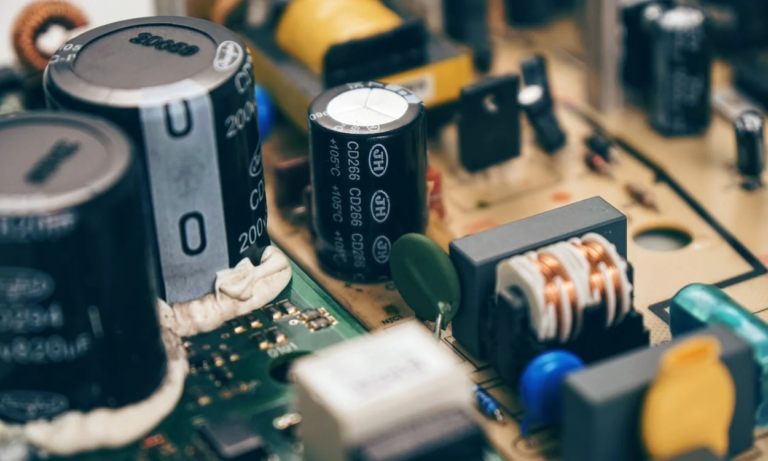

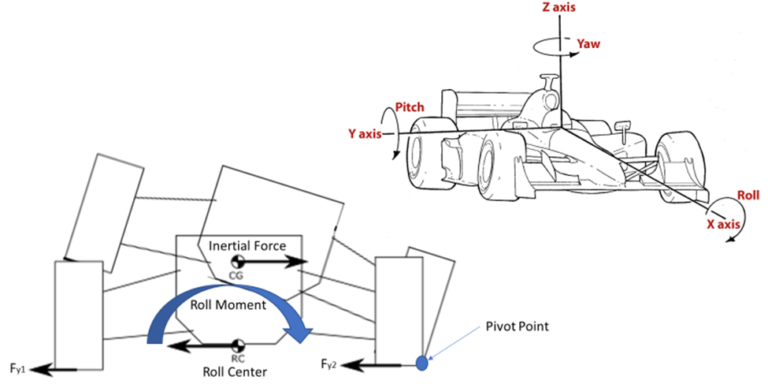


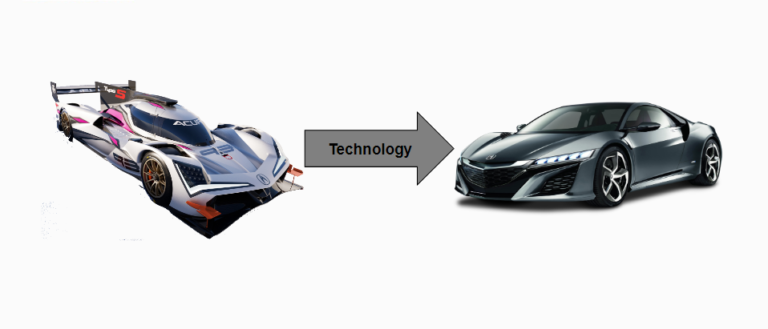
I have recently started a blog, the info you provide on this site has helped me greatly. Thanks for all of your time & work. “Quit worrying about your health. It’ll go away.” by Robert Orben.